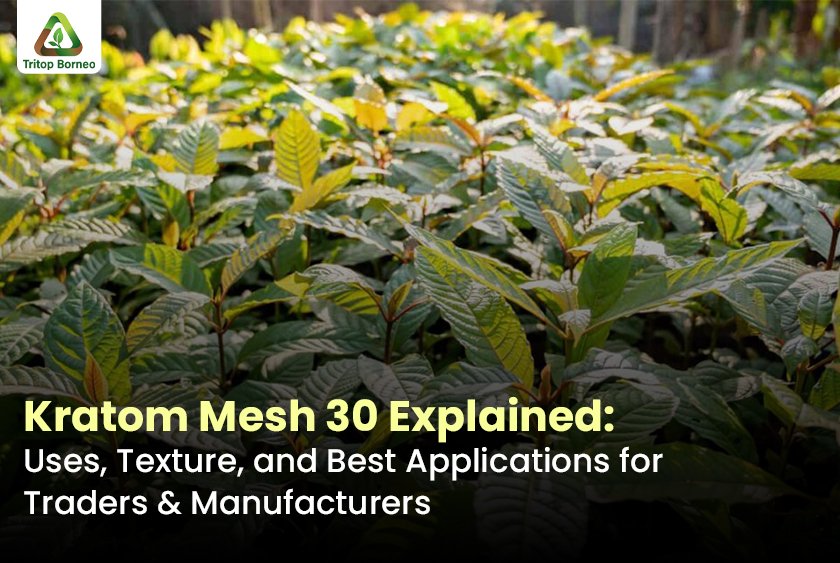Kratom Mesh 30 Explained: Uses, Texture, and Best Applications for Traders & Manufacturers

When Perfect Kratom Goes Wrong: A Hidden Crisis in Consistency
Your kratom checks all the boxes—tested, packed, shipped. Yet, complaints come in.
Tea brews too slowly. Capsules jam the machines. Product returns pile up.
The alkaloid content is on point, and the color’s pristine. So why the quality backlash?
Here’s the reality that too many suppliers overlook: kratom mesh 30 isn’t just a number. It’s the gatekeeper of performance, consistency, and buyer trust. And if you’re ignoring this spec, you’re losing more than just product quality—you’re losing time, reputation, and recurring business.
This article isn’t a technical drill-down for lab folks. It’s for traders, manufacturers, wholesalers, and formulation labs who need kratom to behave the same way—every single batch.
So let’s get the kratom powder mesh explained—and in a way that actually matters to your business.
Understanding the Mesh: What Is Kratom Mesh 30 Really?
At its core, kratom mesh 30 refers to a specific grind size.
- It’s produced by passing kratom leaves through a 30-mesh screen, which contains 30 holes per square inch.
- This results in a medium-coarse texture, with particles averaging around 595 microns.
This isn’t just technical trivia. Mesh 30 kratom powder behaves in a particular way during processing, brewing, and extraction. That behavior determines how smoothly your operations run—and how reliably your buyers can use your product.
So, what is kratom mesh 30 in business terms?
It’s predictability.
It’s reduced rejection rates.
It’s repeatable quality that saves thousands of dollars in the long run.
Why Mesh Size Directly Impacts Commercial Outcomes
Mesh size is far more than just a consistency label—it’s the quiet influencer of nearly every production stage. Whether you're brewing, encapsulating, or formulating extracts, kratom mesh size plays a direct role in:
- Flow rate through machinery
- Extraction speed and completeness
- Moisture absorption and microbial risk
- Storage performance across varying climates
- Uniformity in dosing and fill weight
And here’s a key insight: even a visually perfect kratom batch can fail lab or machine tests just because the mesh size wasn’t controlled.
In short, kratom powder consistency starts—not ends—with mesh size control.
Mesh 30 vs Mesh 60 Kratom: One Decision, Two Very Different Results
Too many businesses still treat mesh size as interchangeable. That’s a dangerous misconception.
Let’s decode the real-world differences between mesh 30 vs mesh 60 kratom:
Mesh 30 (Medium-Coarse, ~595 microns)
- Ideal for brewing kratom tea in bulk
- Minimal dust, easier to handle and pack
- Reduces machinery clogging and filter saturation
- Enables longer shelf life during transport
- Offers a balanced extraction rate without rapid oxidation
Mesh 60 (Fine Powder, ~250 microns)
- Suitable for capsule manufacturing and nano-formulations
- Finer grind means quicker absorption but higher oxidation risk
- More prone to humidity-related clumping
- May lead to inconsistent flow rates in capsule machines
- Requires tighter storage and environmental controls
The choice between the two is not about quality—it’s about application. But for manufacturers, tea brewers, and formulation labs, mesh 30 kratom powder offers the broadest and most reliable performance envelope.
2024–2025 Mesh Trends: Why the Market Is Shifting Toward Mesh 30
Across kratom-exporting nations and importing buyers, we’re seeing an unmistakable shift toward mesh standardization, especially in high-compliance markets like Germany, Canada, and the U.S.
Key developments include:
- GMP-certified processors now include mesh data in their COAs
- Kratom traders and brokers demand single-mesh product lines for better traceability
- A surge in export compliance rejections due to mixed or undefined mesh profiles
- Automated mesh screening systems becoming the new norm in Indonesian processing units
As supply chains tighten and buyers demand greater transparency, standardized kratom mesh size—especially mesh 30—is becoming a default expectation.
Three Powerful Facts That Make Mesh 30 a Strategic Decision
- More than 60% of kratom shipment rejections in Europe (2023) were due to inconsistent or undisclosed mesh sizes, not alkaloid content.
- Mesh 30 kratom powder retained over 96% alkaloid content during long-haul exports in controlled packaging, outperforming both finer and coarser meshes.
- Kratom tea producers in Indonesia and Malaysia now report a 32% improvement in brewing time efficiency when using standardized mesh 30 material.
These aren’t marketing statistics. They’re proof points from labs, ports, and processing floors.
Case Study: When a Mesh Shift Became a Business Breakthrough
A North American herbal wellness brand was facing ongoing delays and rising customer complaints. Their kratom products brewed inconsistently. Their capsule fillers constantly jammed. And their returns? Surging at over 20%.
The turning point?
They moved to a mesh 30 kratom powder supply chain—no more mixed meshes, no visual guessing, just tested, verified grind.
Within one quarter:
- Product rejections dropped to 6%
- Brew times became uniform across their SKUs
- Their top distributor renewed an annual contract—with a larger MOQ
- The capsule line ran 18% faster, cutting down daily operational costs
Sometimes, a technical tweak isn’t just about specs. It’s a complete operational transformation.
A Final Word: Don’t Let Mesh Be the Weakest Link in Your Supply Chain
The difference between a reliable product and a rejected shipment could be hiding in your mesh.
Mesh defines how your kratom performs. It defines how your brand is remembered. For high-volume traders, contract manufacturers, and international exporters, it’s not optional anymore. It’s essential.
Here’s what kratom mesh 30 delivers:
- A dependable texture that won’t ruin your brewing specs
- A grind that machines love and formulations depend on
- A standard that reduces returns, improves consistency, and strengthens buyer trust
You can ignore it, and keep troubleshooting every batch—or you can align with partners who already solved it.
That’s exactly what Tritop Borneo—also known as Tribeka— has done.
They’ve built their business around precision-milled mesh 30 kratom powder, lab-tested for consistency, sealed for shelf life, and documented for international compliance.
They don’t just supply kratom. They deliver control. And that control becomes your competitive edge.
